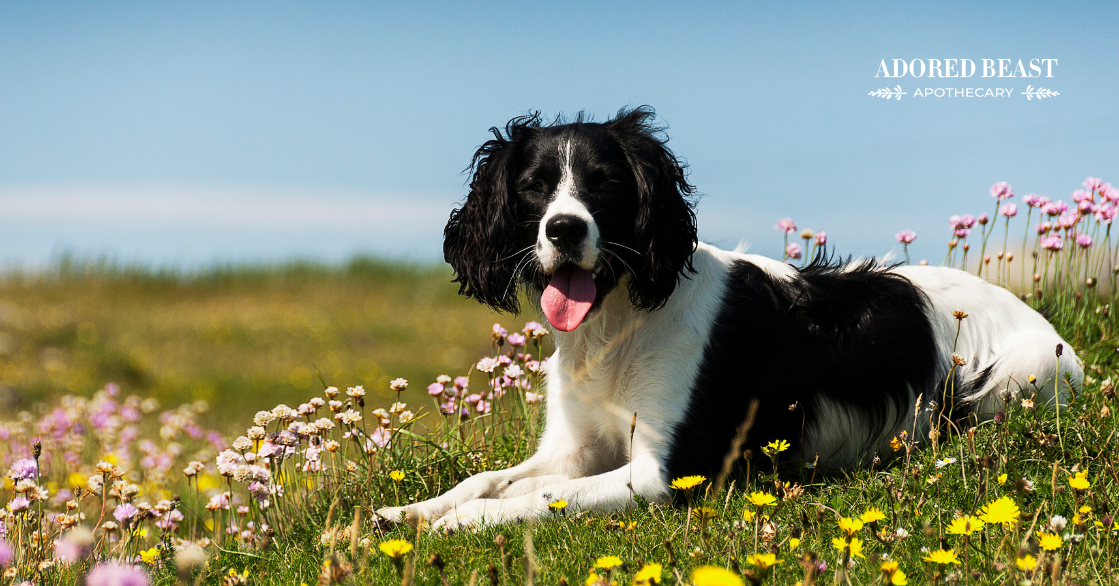Spring is in the air! Literally. Over the next few weeks we’re going to start seeing buds on the trees and green shoots sprouting up from the ground. And then, the pollen…
Just like humans, environmental allergies in dogs are most prominent in the spring. If you have allergies yourself, you know what that means – sniffling, sneezing, runny nose… general discomfort. And if your dog is the same, you know they’re just as uncomfortable, but may display different symptoms (and we’ll talk about those in a minute).
That’s why we’re big believers in not only finding natural solutions to help curb those allergy symptoms, but also preparing the body beforehand to help it better deal with the onslaught!
What follows is our guide to helping you help your pet cope. But first… how can you tell if environmental allergies may be the cause of your animal’s discomfort?
Environmental Allergies in Dogs
Some puppies will show signs of seasonal allergies or sensitivities very young, with most environmental allergies in dogs showing up by age 3. That said, dogs can develop them later in life.
And just like us, our dogs can have seasonal allergies to certain things in their environment. Some common environmental allergens are:
- Pollen
- Grass
- Weeds
- Mold
- Dust mites (these may be more prevalent in the winter, unless you’re doing lots of spring cleaning!!)
- Leaf mold
Yes, all things that seem to be creeping up this time of year…
Often the best way to determine if it is an environmental allergy is timing. If the symptoms start to show up more in spring and fall, but tend to calm in the winter and summer, it’s probably environmental in nature. That said, the heat in the summer can exacerbate skin issues.
Watch for these common symptoms as the seasons change:
- licking at their paws
- generalized hair loss
- watery eyes
- runny nose
- scratching, chewing, biting
- skin damage due to scratching or licking
- ear infections
- gastric reflux
So can you help your beloved beast when spring allergens are in the air?
[RELATED] How to get ahead of seasonal allergies – start prepping now!
Prepping for Environmental Allergies in Dogs
Right now, get the body ready to better deal with allergy season.
1. Heal the Gut
Your dog’s allergy symptoms may be exacerbated if their digestive system is not functioning as a balanced system.
Histamine is part of what causes a reactive/allergic/trauma response to allergic stimuli. It’s the body’s defence against foreign proteins in the blood. The body sees an “attack”, releases mast cells that then release histamine, and this causes the body to react. For example, hives are the body’s reaction to that release of histamine. (Hence the use of anti-histamines for allergies, bee stings, etc!!) A healthy gut environment = balanced histamine and immune system. The gut microbiome is made up of trillions of bacteria, viruses, and fungi. While some bacteria are associated with disease (we call those harmful bacteria), others are actually really important for the immune system (we think of these as the helpful bacteria). A healthy gut environment has way more helpful bacteria telling the harmful bacteria to hit the curb!
A healthy gut helps to keep unwanted allergens from entering the bloodstream. As an example, if your dog is reactive to pollen, and licks their paws, you want the gut to be able to contain that pollen and excrete it. If the gut is unhealthy, and your dog ingests that pollen, it can leak into the bloodstream, causing a major reaction.
To create that healthy environment:
- bring on the pre- and probiotics
- opt for fresh food
- avoid harsh antibiotics and drugs when you can
- reduce stress
- address leaky gut syndrome
- work on supporting the detox organs
2. Optimize with Omega-3s
Omega-3s have incredible anti-inflammatory properties that many dogs need during allergy season. Those anti-inflammatory properties that help with arthritis, pain relief, and immune-modulation – the ones omegas are best know for – can also help relieve allergies. Our Potent-Sea is a sustainable alternative to fish oil that provides higher-than-average EPA and DHA levels, but it doesn’t harm the ocean!
3. Get Ahead of Infamous Yeast
Some dogs’ yeast symptoms are exponentially heightened in the spring. Additionally, environmental allergies can sometimes bring on the yeast! For example, if allergies cause inflammation in the ear canal, this can cause it to narrow and inhibit the flow of oxygen into the ear. It then becomes warm and moist, creating the perfect environment for yeast to flourish. The same with their paws. If they get itchy, and start licking their paws, they stay damp and warm, and the yeast starts to grow.
Tip: Our Yeasty Beast Protocol can help address yeast at the root.
4. Natural Bedding!
Science tells us that synthetic materials harbour pathogenic bacteria and yeast far more than natural materials like cotton and bamboo. And that makes sense – cotton and bamboo breathe!! Airflow really helps discourage the growth of those nasties (mold, yeast, dust mites).
If you can’t replace your dog’s bed, that’s ok. Make sure to give it a wash on a regular basis (hot water only, or add a drop of organic lavender essential oil to your washing machine), and place a cotton or bamboo towel or sheet on top.
5. Liver Support
A healthy liver = correct breakdown of histamine, effective detoxification, and a million other things the liver does!
There are lots of amazing herbs that aid the liver, helping to boost its effectiveness. These are our favourites:
- Celandine (Chelidonium) – helps battle harmful organisms at the same time protecting the liver
- Dandelion (Tracacum Officinate) – helps detoxify the liver
- Barberry (Berberis) – inhibits the growth of harmful bacteria and boosts the immune system
- Milk Thistle (Cardus Marianus) – stabilizes liver cell membranes, protects from free radical damage, helps regenerate healthy liver cells and boosts the organ’s ability to filter toxins from the blood
These herbs are great on their own, but when you combine them they work synergistically to have an even greater effect. HINT: That’s what we did with our Liver Tonic!
Helping Your Dog Cope with Seasonal Allergies
Once the allergies start to rear their ugly heads, there are other steps you can take to help.
1. Quercetin
Also known as “Nature’s Benadryl”, quercetin is a flavonoid found in many different plants. It’s a go-to for allergies because of how it influences multiple biological pathways and immune cell functions in the allergic immune response. It interacts with proteins to help modulate the process of allergic reactions and to inhibit histamine release in the body.
You can easily introduce more quercetin in your dog’s diet by rotating in a few of these:
- berries
- apples
- green tea
- kale
- broccoli
- asparagus
It’s also in red wine, but keep that for your allergies only!
2. Stop Bathing Your Dog
Yes, you read that right!
We talked above about the beneficial bacteria in the gut… the same holds true for the skin – both yours and your dog’s! (You can read more on this right here).
With environmental allergies in dogs (or really anytime), using soap or shampoo destroys the natural bacteria on the skin, which helps defend against harmful bacteria and environmental insults. While it’s important to remove environmental allergens from your dog’s skin and coat, there are more gentle ways of doing it that don’t strip your dog’s skin of its natural defence mechanism.
- Rinse with water, then follow with a chamomile/green tea leave-on rinse. Use a ratio of 1/4 tea to 3/4 water. Pour it on and just let it soak in – don’t rinse it off.
- Make a probiotic yogurt or kefir mask. This will help give the skin microbiome a boost. Use a ratio of 3 tablespoons of organic yogurt to 1/2 tsp of a probiotic that has at least 10 strains and 30 billion CFUs. Increase the amount of yogurt and probiotic as needed for the size of your dog. Leave it on for at least 15 minutes (30 minutes is ideal) – but only as long as it doesn’t stress your dog out. Then rinse with JUST water.
Julie’s recommendation: Do the probiotic mask twice a week, followed by the tea rinse. Then, any time your dog is out rolling in the grass, running through the park, etc., just do the rinse.
3. Homeopathy
There are several remedies that can be helpful in curbing allergy symptoms.
Julie’s favorites are:
- Aconite and Arnica, given together, if your dog has scratched their skin raw and is beside themselves with the itch. 30c or 200c, repeated every hour, 3-4 times.
- Sulphur, Berberis, Nux Vomica, Echinacea, Graphites in combination – for chronic allergies. Give twice a day for 7 days, then use as needed.
- Thuja and Silica are really good if you think that your dog has had allergies following a vaccine, even 6 months later. Give twice a day for 2 days, then repeat as needed.
If your dog gets worse, stop immediately and reassess 3 days later. Often, the symptoms will get better after a period of aggravation.
If your dog has severe allergies, Julie always recommends getting in touch with an animal homeopath for a custom plan.
4. Share the Love!!
Cross-species contaminate (in a good way LOL). Before you have a shower or bath, take a clean cotton towel and rub down your healthy skin. Take that towel and put it on top of your dog’s bed. Your natural bacteria will help create a diverse community of organisms to protect your dog. This also has the beneficial addition of leaving your pheromones behind – it makes your dog feel closer to you whenever you’re away from the house.
5. Fill the Kiddy Pool
Go to a nursery and fill the pool with different organic dirt and material like organic compost and manure. Then, let your dog roll in it, dig in, bury toys in it. You can even add water to make mud, let them play in it, let it sit on their skin, then hose them off with just water and NO soap. For apartments, get flower planters that are flat and use them.
6. Keep Stress to a Minimum
Stress raises cortisol levels which can make your dog even more susceptible to allergies and the resulting itch.
- Give your dog things to do so they don’t get bored – raw bones or other types of stimulation.
- Don’t stop touching your dog because he is suffering with skin issues. This then becomes not only a physical disease but emotional isolation.
- If a cone is absolutely required, try to find something that is as comfortable as possible. Soft, flexible, or inflatable – not sharp or really restricting.
- A good quality CBD oil may help to reduce anxiety and stress around scratching.
Don’t get discouraged. Environmental allergies in dogs are common, but with a little attention and effort you can really help to mitigate the symptoms and keep your pet from literally pulling their hair out.












